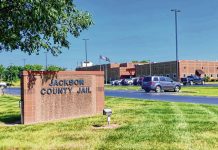The Bartholomew County Commissioners have signed a petition to the Bartholomew County Drainage Board to request a new regulated drain in the Clifford area, fulfilling a promise made years ago.
The underground tile would begin in the Clifford Town Park, move east along the south side of County Road 550N, and then north on the east side of County Road 250E up to County Road 600N.
“This is really a matter of taking care of an obligation that the Bartholomew County Commissioners made over 20 years ago,” said Commissioner Carl Lienhoop. He emphasized the benefits for many in the Clifford area will outweigh costs, damages and expenses.
Specifically, the project will improve drainage and public health through the east side of Clifford, as well as on the rural areas along County Road 250E, Lienhoop said.
The years-ago promise was made in connection with the $10.5 million effort to widen County Road 600N between Clifford and Hope. Due to numerous delays, the multi-phase project road and bridge project dragged on for 19 years until it was completed near the Armuth Acres subdivision in 2013.
One snag occurred in 1998 when several landowners demanded compensation for right-of-way property needed to expand the road. Those financial demands caught elected officials off-guard, because it was well known the Road 600N improvements were a public safety issue, especially for children on their way to school.
The improvements had long been requested by Flat Rock-Hawcreek School Corp. At the time, County Road 600N between Clifford and Hope was situated on “roller coaster terrain with narrow lanes and missing shoulders.”
The road was so narrow that it made it impossible for school bus drivers to squeeze by oncoming traffic, said the late former Flat Rock-Hawcreek superintendent Glen Keller in a 2013 interview with The Republic.
Deteriorating bridges that crossed the Big Tough and Horse creeks were so dangerous when covered with ice and snow that school bus drivers feared lives were being placed in danger by attempting to cross them, Keller said then. He died in September 2017.
The Bartholomew County Commissioners at the time (Byron Carr, Paul Franke and Larry Kleinhenz) refused to pay the amounts demanded by several landowners for right-of-way.
However, farmer Nathan Don Scheidt refused to charge the county anything for using his property. Instead, he only asked that the county agree to eventually improve the storm drainage along County Road 250E, between Clifford and Road 600N.
Scheidt was a Flat Rock-Hawcreek school bus driver, so he understood the dangerous risks that children under his care, as well as himself, were facing, Keller said in 2013.
Ten years after the deal was made, the requested storm drainage was still not installed when Scheidt died in May 2008, at the age of 76.
“So many times, we were on the fringe of getting it done, but it just didn’t happen,” Lienhoop said.
The five-member Bartholomew County Drainage Board will receive an introduction to the petition when they meet at 6:30 p.m. Monday in the fourth floor council chambers in the Bartholomew County Governmental Office Building.
However, there will have to be two public hearings before decisions on the petition can be made, according to Tom Finke, a county hydrologist who organizes most drainage board activities and agenda items.
It’s likely that board members will only discuss a schedule for the petition process Monday, with discussions and decisions likely to take place late this year, Finke said.
Kleinhenz emphasized to residents of both Clifford and the nearby Armuth Acres subdivision that there will be no assessment with the installation of this regulated drain.
“We will pay for the installation,” said Kleinhenz, adding the Bartholomew County Drainage Board should be willing to accept responsibility for ongoing maintenance of the new drain, because it will be a easy-to-manage buried tile, rather than an open service drain.
That may be a sensitive issue to some residents of Armuth Acres and the North Cliff subdivision, where flooding caused by inadequate drainage became a significant problem last spring. However, several homeowners withdrew their names from a petition to have the problems fixed in 2003 after discovering it would cost about $5,000 per person.
Solutions are still being examined to see if the drainage in those two neighborhoods can be improved without excessive expense to property owners, Lienhoop said.




